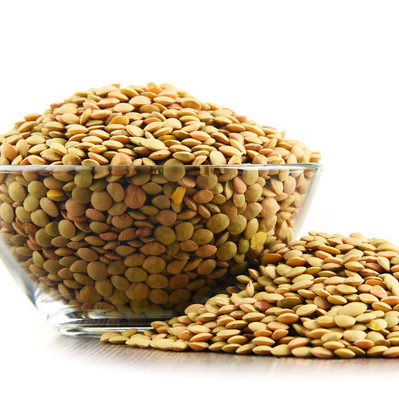
Lentil
What is Lentil?
Lentil (Lens culinaris) is a crop belonging to the Fabaceae legume family. These edible and lens-shaped seeds grow in flat or short pods. They are a popular food staple in Asian and North African dishes.
- Although they are never eaten fresh, rather dried and then cooked.
- Different varieties and types of pulse have varying sizes, colors, shapes, and tastes.
The most common types of lentils are:
- Brown (European)
- Green (French)
- Yellow
- Red (Spilt or Egyptian)
- Black (Beluga)
Origin of lentils
This food crop is among one of the oldest cultivated and domesticated crops in the world. The word ‘lentil’ originated from the Latin word, ‘lens’. Archeological research around the banks of the Euphrates revealed remnants of this pulse. It is believed to have existed as far back as 8, 000 BC.
Further studies revealed that the Egyptians, Romans, and Hebrews all consumed this crop. The Bible also offers an account of this food in the story of Esau, who sold his birthright for a pot of pottage. In the early 1900s, this crop found its way into the USA. Today, many varieties of this crop are cultivated all over the world.
Function
This food performs many functions. It is used in the kitchen for dishes, such as salads, soups, stews, casseroles. Additionally, this crop is a good alternative to cereal grains. It can be used as a feed for livestock and as green manure for crops.
Nutrition
A 100g serving of this food, when cooked, provides:
- 116 calories
- 20.13g of carbohydrates
- 7.9g of fiber
- 1.8g of sugar
- 9.03g of protein
- 0.38g of fats
This pulse also supplies the body with essential nutrients such as iron, folate, manganese, prosperous, thiamin, potassium, zinc, and magnesium.
Some health benefits associated with lentils include:
- Improving heart health
- Preventing neural tube defects in newborns
- Reducing the risk of developing cancer
- Protecting against iron deficiency
- Encouraging weight loss
- Aiding digestion
However, consuming an excessive amount of this food may cause constipation and abdominal discomfort.
Commercial production
Canada is the world’s largest producer of this crop, while the USA ranks fourth in global production. 6.56 million metric tons of this legume were produced worldwide in 2016. The following year, production rose to 7.6 million metric tons.
This legume adapts to cool weather conditions. However, extreme rainfall and high humidity affect the yield and seed quality. This crop thrives in well-drained soil types, including loam and sand. A soil pH of near 7.0 is recommended for commercial production.
The seedlings of this crop should be immunized with Rhizobium Leguminosarum within 24 hours of planting. Following the right cultivation practices will ensure a good yield. Best practices for this crop include seedbed preparation, incorporating a seeding system, following fertility requirements, sorting varieties, weed, disease, and pest control, as well as harvesting, drying, and storage.
Application
Lentils can be bought dried or canned. However, bear in mind that the canned variety often costs more than the dried variety. The method and lifespan for storing dried and canned versions of this food differ.
Dry lentils can be stored in an airtight container in the cupboard or in a cool, dry place. Storing them this way allows them to last up to a year. Once cooked, this pulse should be covered and refrigerated within two hours. If stored correctly, they can last up to a week. Storing them in the freezer in an airtight container allows you to keep them for up to six months.
Canned types of this food can be kept in the cupboard or a cool, dry place, and can last up to a year. When the can is opened and rinsed, it is best to remove the lentils from the can and store them in a covered glass or airtight container in the refrigerator. This way, they can last up to 4 days. If you intend to store them for one to two months, then the freezer is the best option.
Lentil recipes
This legume adds flavor and nutrients to a range of dishes. Here are some popular recipes:
- Quick Coconut Lentil Curry
- Moroccan Lentil Quinoa Soup
- White Bean Cassoulet with Pork and Lentils
- Spicy Lentil Nachos with Three Cheese Sauce
- Zucchini-Lentil Fritters with Lemony Yogurt
FDA Regulation
The Food & Drug Administration defines this food as a rarely consumed raw agricultural commodity. Therefore, they don’t regulate the growing, harvesting, packing, or holding of this crop. Furthermore, they classify this crop as a type of dry grain or seed. The FDA also regulates its use in contact with the processing of Jute fiber employed in the production of textile bags using mineral oils.
References
“Lentil.” Encyclopaedia Britannica, Encyclopaedia Britannica, 21 May 2020, www.britannica.com/plant/lentil-plant.
“Lentils: Benefits and Nutrition.” MedicalNewsToday.com, MediLexicon International, www.medicalnewstoday.com/articles/297638?sa=X
“All About Lentils. Tips on How to Use, Buy and Store Lentils” UnlockFood.ca, Unlock Food Blog, www.unlockfood.ca/en/Articles/Cooking-And-Food/Legumes,-Soy,-Nuts-and-Seeds/All-About-Lentils.aspx
“CFR – Code of Federal Regulations, Title 21.” Accessdata.fda.gov, U.S Food & Drug Administration, 1 Apr. 2019 https://www.accessdata.fda.gov/scripts/cdrh/cfdocs/cfcfr/CFRSearch.cfm?fr=112.2&SearchTerm=lentil
